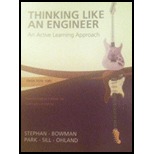
Concept explainers
- 1. A history major of your acquaintance is studying agricultural commerce in nineteenth century Wales. He has encountered many references to “hobbits” of grain, and thinking that this must be some type of unit similar to a bushel (rather than a diminutive inhabitant of Middle Earth), he has sought your advice because he knows you are studying unit conversions in your engineering class.
He provides a worksheet containing yearly records for the total number of hobbits of three commodities sold by a Mr. Thomas between 1817 and 1824, and he has asked you to convert these to not only cubic meters, but also both U.S. and imperial bushels.
| A | B | C | D | E | F | G | H | I | J | K | L | M | |
| 1 | |||||||||||||
| 2 | |||||||||||||
| 3 | |||||||||||||
| 4 | |||||||||||||
| 5 | Barley | Wheat | Oats | ||||||||||
| 6 | Year | Hobbits | Imp. Bushels | US Bushels | Cubic Meters | Hobbits | Imp. Bushels | US Bushels | Cubic Meters | Hobbits | Imp. Bushels | US Bushels | Cubic Meters |
| 7 | 1817 | 105 | 154 | 203 | |||||||||
| 8 | 1818 | 118 | 145 | 187 | |||||||||
| 9 | 1819 | 98 | 167 | 167 | |||||||||
| 10 | 1820 | 187 | 324 | 199 | |||||||||
| 11 | 1821 | 102 | 105 | 210 | |||||||||
| 12 | 1822 | 142 | 168 | 147 | |||||||||
| 13 | 1823 | 93 | 132 | 168 | |||||||||
| 14 | 1824 | 117 | 136 | 193 | |||||||||
| 15 | |||||||||||||
| 16 | hobbits | Imp. Bushels | US Bushels | Cubic motors | |||||||||
| 17 | 1 | ||||||||||||
After a little research, you find that the hobbit was equal to two and a half imperial bushels, the imperial bushel equals 2219 cubic inches, and the U.S. bushel equals 2150 cubic inches.
First, you create a table showing the conversion factors from hobbits to the other units, including comments documenting the conversion. You then use these calculated conversion factors to create the rest of the table.
Want to see the full answer?
Check out a sample textbook solution
Chapter 10 Solutions
Thinking Like an Engineer
Additional Engineering Textbook Solutions
Elementary Surveying: An Introduction To Geomatics (15th Edition)
Starting Out with Java: From Control Structures through Data Structures (4th Edition) (What's New in Computer Science)
Electric Circuits. (11th Edition)
Vector Mechanics For Engineers
Experiencing MIS
Database Concepts (8th Edition)
- I am not able to solve this question. Each part doesn't make sense to me.arrow_forwardExercises Find the solution of the following Differential Equations 1) y" + y = 3x² 3) "+2y+3y=27x 5) y"+y=6sin(x) 7) y"+4y+4y = 18 cosh(x) 9) (4)-5y"+4y = 10 cos(x) 11) y"+y=x²+x 13) y"-2y+y=e* 15) y+2y"-y'-2y=1-4x³ 2) y"+2y' + y = x² 4) "+y=-30 sin(4x) 6) y"+4y+3y=sin(x)+2 cos(x) 8) y"-2y+2y= 2e* cos(x) 10) y+y-2y=3e* 12) y"-y=e* 14) y"+y+y=x+4x³ +12x² 16) y"-2y+2y=2e* cos(x)arrow_forwardQu. 15 What are the indices for the Plane 1 drawn in the following sketch? Qu. 16 What are the Miller indices for the Plane shown in the following cubic unit cell? this is material engineering please show all workarrow_forward
 Automotive Technology: A Systems Approach (MindTa...Mechanical EngineeringISBN:9781133612315Author:Jack Erjavec, Rob ThompsonPublisher:Cengage Learning
Automotive Technology: A Systems Approach (MindTa...Mechanical EngineeringISBN:9781133612315Author:Jack Erjavec, Rob ThompsonPublisher:Cengage Learning
